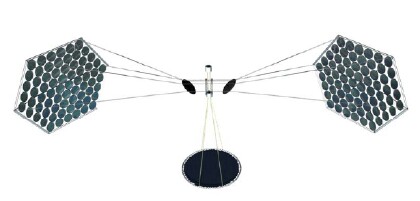Congressman Kirk and Space Solar Power

Space Based Solar Power Satellite Illustration from NSSO Report
Yesterday I attended a Candidate and Issue Forum sponsored by the Schaumburg Township Republican Organization. The featured speaker was U.S. Representative Mark Kirk. Congressman Kirk is a member of the House Committee on Appropriations as well as the House Renewable Energy and Energy Efficiency Caucus and the Congressional Climate Change Caucus. Congressman Kirk represents the 10th District and is a popular representative here in Illinois.
Because of the congressman's membership on the House Renewable Energy and Energy Efficiency Caucus, I was interested in learning about his position on space solar power. The question that I asked of Congressman Kirk was if during his time on the Renewable Energy Caucus the general subject of space solar power had been discussed and if the caucus had specifically considered the findings and recommendations of the National Space Security Office Space-Based Solar Power As an Opportunity for Strategic Security Feasibility Study. The congressman quickly described the SSP concept at a very high level as large structures in space beaming energy to Earth and referred to it as an exotic energy source which he readily dismissed by quoting one number: launch costs of $10,000 per pound. Congressman Kirk then went on to discuss a variety of other alternative and renewable energy options.
While I was disappointed by his dismissive attitude, he did correctly identify the Achilles' Heel of Space Solar Power: the cost of access to space. It should be noted that the cost of access to orbit is not the best single number to use in quantifying the cost of space solar power. Rather the discussion should concentrate on the mass required to produce a kilowatt of electricity (kg/kw) and the total system cost to produce a kilowatt of electricity (cost/kw)
Some thirty years ago, Gerard K. O'Neill recognized that launch costs were the central problem associated with the construction of a system of solar power satellites. In his paper Space Colonies and Energy Supply to the Earth (Science, 5 Dec 1975), O'Neill also identified the increasing demand for power as well as the environmental impacts of its production. His visionary solution was to propose the creation of a Space Manufacturing Facility at either the L4 or L5 Libration points which would be supplied by raw materials mined from the Moon. This would drastically reduce over the long term the amount of mass that had to be delivered to space from Earth. More importantly, it would be the first step in the creation of a spacefaring civilization. While this may sound like science fiction, recall that powered flight, space travel, submarines, and nuclear power were all once science fiction. Following are two quotes regarding nuclear power from a couple of visionary scientists.
There is not the slightest indication that (nuclear) energy will ever be obtainable. It would mean that the atom would have to be shattered at will. – Albert Einstein, 1932
Anyone who looks for a source of power in the transformation of the atom is talking moonshine. – Ernest Rutherford, 1936
In other space solar power related news, I will be participating in the Space Solar Power track of programs at the upcoming International Space Development Conference in Florida. I will be a member of the USA and International Strategic, Policy and Technology Issues panel. My co-panelist Kent Tobiska of Space Environment Technologies will give a short presentation on Terrestrial and Space-based Solar Power Systems for Desalination in S. California and Ben Shelef of Spaceward Foundation will give a short presentation on Tie-in between SBSP and the Space Elevator architecture. The title of my segment is The Strategic and Policy Issues of SSP. This will not be a formal presentation. Instead I will share my views with the audience and my co-panelists and solicit their input with respect to my observations. Not being an engineer, I am not in a position to speculate on the engineering aspects of space solar power. However, as a reasonably well informed citizen, I can attempt to understand the social and political objections to space solar power in light of growing world demand for energy – especially green energy. Understanding the societal and political obstacles to space solar power will make it possible to formulate an effective response to those objections, something that lies within the realm of the capabilities of activist organizations.
I have also taken on the job of serving as administrator for the SSAFE (Space Solar Alliance for Future Energy) web site and blog. That is one way in which I can contribute to the dissemination of knowledge about space solar power.
Ad Astra, Jim
| Return to the Blog Index | This entry was posted on Sunday, May 10th, 2009 at 9:01 pm and is filed under Space Exploration.